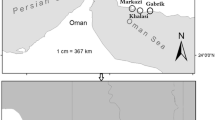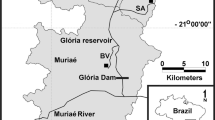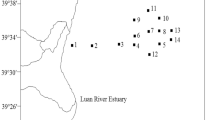Abstract
Floodplains are important and distinctive ecosystems around the world, and the recruitment of ichthyoplankton from river to floodplain lakes is crucial to maintain this unique ecosystem. However, this process has not been well documented. In this study, ichthyoplankton were sampled to investigate the details of ichthyoplankton recruitment from the Changjiang (Yangtze) River to the Dongting Lake via a floodway channel, the Songzi River, from May to July in 2013 and 2014. During the study period, 41 species of eggs and larvae were sampled. Among the samples, 16 were river-lake migratory species (RL), representing 23.5% of the species in the Dongting Lake. In 2013, an estimated 130 million eggs and 3 180 million larvae drifted through the sampling section, and in 2014, an estimated 1 060 million eggs and 1 040 million larvae drifted through the sampling section. The amount of eggs and larvae of RL reached 3 210 million in 2013 and 1 850 million in 2014, respectively. These results demonstrated the importance of ichthyoplankton recruitment from the river to the lake, as species diversity will decrease sharply without this recruitment. Canonical correspondence analysis (CCA) showed that water temperature and water flow are the two most important factors influencing the spawning activities of fish. To maintain the high fish diversity in the Changjiang floodplain, we suggest to irrigate the channel to increase water discharge and increase the transport of ichthyoplankton from the Changjiang mainstream into the Dongting Lake.
Similar content being viewed by others
References
Bénech V, Peñáz M. 1995. An outline on lateral fish migrations within the Central Delta of the Niger River, Mali. Hydrobiologia, 303(1–3): 149–157, https://doi.org/10.1007/BF00034052.
Burgess O T, Pine W E, Walsh S J. 2013. Importance of floodplain connectivity to fish populations in the Apalachicola River, Florida. River Research and Applications, 29(6): 718–733, https://doi.org/10.1002/rra.2567.
Cao W X, Chang J B, Qiao Y, Duan Z H. 2007. Fish Resources of Early Life History Stages in Yangtze River. China Water Power Press, Beijing. (in Chinese)
Cao W X. 2011. Current situation and protection countermeasures of fish resources in the Yangtze River. Jiangxi Fishery Science and Technology, 2: 1–3. (in Chinese)
Chang J B, Cao W X. 1999. Fishery significance of the river-communicating lakes and strategies for the management of fish resources. Resources and Environment in the Yangtze Basin, 8(2): 153–157. (in Chinese with English abstract)
Chen D Q, Duan X B, Liu S P, Shi W G, Wang B. 2002. On the dynamics of fishery resources of the Yangtze River and its management. Acta Hydrobiologica Sinica, 26(6): 685–690. (in Chinese with English abstract)
Chen Y Y, Xu Y X. 1995. Hydrobiology and Resources Exploitation in Honghu Lake. Science Press, Beijing. (in Chinese)
Copp G H. 1989. The habitat diversity and fish reproductive function of floodplain ecosystems. Environmental Biology of Fishes, 26(1): 1–27, https://doi.org/10.1007/BF00002472.
Dou H S, Jiang J H. 2000. Dongting Lake. University of Science and Technology of China Press, Hefei. (in Chinese)
Duan X B, Liu S P, Huang M G, Qiu S L, Li Z H, Wang K, Chen D Q. 2009. Changes in abundance of larvae of the four domestic chinese carps in the middle reach of the Yangtze River, China, before and after closing of the three gorges dam. Environmental Biology of Fishes, 86(1): 13–22, https://doi.org/10.1007/s10641-009-9498-z.
Fang C M, Chen W J, Zhou H M, Zhang Y P, Fu P F, He G, Wu B, Wang S. 2016. Fish resources and its utilization suggestions of Lake Poyang. Jiangsu Agricultural Science, 44(9): 233–242, 243. (in Chinese)
Fang C M, Hu C H, Chen X J. 2014. Impacts of Three Georges Reservoir’s operation on outflow of the three outlets of Jingjiang River and Dongting Lake. Journal of Hydraulic Engineering, 5(1): 36–41. (in Chinese with English abstract)
Fang J Y, Wang Z H, Zhao S Q, Li Y K, Tang Z Y, Yu D, Ni L Y, Liu H Z, Xie P, Da L J, Li Z Q, Zheng C Y. 2006. Biodiversity changes in the lakes of the Central Yangtze. Frontiers in Ecology and the Environment, 4(7): 369–377, https://doi.org/10.1890/1540-9295(2006)004[0369:BCITLO]2.0.CO;2.
Han Q W, Zhou S H. 1999. Characteristics and fluvial processes of diffluent rivers from Changjiang River to Dongting Lake. Journal of Yangtze River Scientific Research Institute, 16(5): 5–8. (in Chinese with English abstract)
Hu G W, Mao D H, Li Z Z, Zeng Y, Feng C. 2014. Characteristics and driving factors of runoff and sediment changes fluxes into the Dongting Lake from three outlets in Jingjiang river during past 60 years. Journal of Natural Resources, 29(1): 129–141. (in Chinese with English abstract)
Huang G T, Xie P. 1996. Changes in the structure of fish community with the analysis on the possible reasons in Lake Donghu, Wuhan. Acta Hydrobiologica Sinica, 20(S1): 38–46. (in Chinese with English abstract)
Humphries P, Serafini L G, King A J. 2002. River regulation and fish larvae: Variation through space and time. Freshwater Biology, 47(7): 1307–1331, https://doi.org/10.1046/j.1365-2427.2002.00871.x
Jiang W, Liu H Z, Duan Z H, Cao W X. 2010. Seasonal variation in drifting eggs and larvae in the upper Yangtze, China. Zoological Science, 27(5): 402–209, https://doi.org/10.2108/zsj.27.402.
Kottelat M, Whitten T. 1996. Freshwater biodiversity in Asia with special reference to fish. In: World Bank Technical Paper, No. 343. The World Bank, Washington DC. p. 17–21, https://doi.org/10.1596/0-8213-3808-0.
Li J Q, Wang D L, Ding D M. 2013a. Research progress of fish resources in Dongting lake. Journal of Anhui Agricultural Science, 41(9): 3898–3900. (in Chinese with English abstract)
Li M Z, Duan Z H, Gao X, Cao W X, Liu H Z. 2016. Impact of the Three Gorges Dam on reproduction of four major Chinese carps species in the middle reaches of the Changjiang River. Chinese Journal of Oceanology and Limnology, 34(5): 885–893, https://doi.org/10.1007/s00343-016-4303-2.
Li M Z, Gao X, Yang S R, Duan Z H, Cao W X, Liu H Z. 2013b. Effects of environmental factors on natural reproduction of the four major Chinese carps in the Yangtze River, China. Zoological Science, 30(4): 296–303, https://doi.org/10.2108/zsj.30.296.
Li T T, Shen Y. 2005. A study on biodiversity conversation in Dongting Lake area. Territory & Natural Resources Study, (1): 38–40. (in chinese with English abstract)
Li Y T, Guo X H, Tang J W, Sun Z H. 2009. Changes on runoff diversion from Jingjiang Reach of the Yangtze River to Dongting Lake after the operation of Three Gorges Reservoir. Journal of Basic Science and Engineering, 17(1): 21–31. (in Chinese with English abstract)
Liang Z S, Zhou C S, Huang H N. 1981. Composition and seasonal changes of fishes in Lake Wuhu connected with Changjiang River. Oceanoligia et Limnologia Sinica, 12(5): 468–478. (in Chinese with English abstract)
Liao F C, He W, Huang X R, Jing Q L, He X C. 2002. Studies on present situation and change trend of Dongting Lake fishery resources and enviroment. Acta Hydrobiologica Sinica, 26(6): 623–627. (in Chinese with English abstract)
Liao F C, He X C, He W, Wang H W, Xu D P. 2006. Status and protective regulation countermeasure in fishery resources and its environment of Dongting Lake. Journal of Yueyang Vocational Technical College, 21(6): 32–37. (in Chinese with English abstract)
Martens K, Segers H. 2009. Endemism in aquatic ecosystems. In: Encyclopedia of Inland Waters. Academic Press, Oxford. p.423–430.
Mu H X, Li M Z, Liu H Z, Cao W X. 2014. Analysis of fish eggs and larvae flowing into the three gorges reservoir on the Yangtze River, China. Fisheries Science, 80(3): 505–515, https://doi.org/10.1007/s12562-014-0729-7.
Olson D M, Dinerstein E. 2002. The global 200: priority ecoregions for global conservation. Annals of the Missouri Botanical Garden, 89(2): 199–224, https://doi.org/10.2307/3298564.
Qiu S L, Liu S P, Huang M G, Chen D Q, Duan X B. 2002. Monitoring of spawning sites of four major Chinese carps in the middle sector of Yangtze River. Acta Hydrobiologica Sinica, 26(6): 716–718. (in Chinese)
Ru H J, Liu X Q, Huang X R, Ning Y Z, Wang H Z. 2008. Diversity of fish species and its spatio-temporal variations in Lake Dongting, a large Yangtze-connected lake. Journal of Lake Sciences, 20(1): 93–99. (in Chinese with English abstract)
Sun S L, Shen J. 2015. Research on evolution and regulation of the Songzi river. Journal of Water Resources Research, 4(6): 559–566. (in Chinese with English abstract)
Tan X C, Li X H, Tao J P, Li J, Wang C, Luo J R, Lai Z N. 2007. Spatial and temporal distribution of larval rusources of fishes in Xijiang River. Freshwater Fisheries, 37(4): 37–40. (in Chinese with English abstract)
Tang J H, Qian M Q. 1979. Fish fauna in Dongting Lake. Inland Fisheries, (10): 24–32. (in Chinese)
Ter Braak C J F, Prentice I C. 1988. A theory of gradient analysis. Advances in Ecological Research, 18: 271–317, https://doi.org/10.1016/S0065-2504(08)60183-X.
Ter Braak C J, Smilauer P. 2002. Canoco reference manual and canodraw for windows user’s guide: Software for canonical community ordination (Version 4. 5). Microcomputer Power, New York.
Tockner K, Stanford J A. 2002. Riverine flood plains: Present state and future trends. Environmental Conservation, 29(3): 308–330, https://doi.org/10.1017/S037689290200022X.
Wang C P, Yu Q H, Zhang L M. 2013. Preliminary discussion on relevant issues of sluice construction at Songzi Entrance on Jinjiang River. Yangtze River, 44(24): 20–22. (in Chinese with English abstract)
Wang S Y, Liao W G, Chen D Q, Duan X B, Peng Q D, Wang K, Li C. 2008. Analysis of ecohydrological characteristics of the four Chinese farmed carps spawning grounds in the middle reach of the Yangtze River. Resources and Environment in the Yangtze Basin, 17(6): 298–798. (in Chinese with English abstract)
Wu G X, Liu L H, Wang Z L, Cao W X, Wang Z X. 1988. Investigation on natural reproduction of Ctenopharyngodon idellus in Jinshajiang of upper Yangtze River. Freshwater Fisheries, (1): 3–6. (in Chinese)
Xie P. 2017. Ecological impacts of three Gorges dam on Lakes Dongting and Poyang. Resources and Environment in the Yangtze Basin, 26(10): 1607–1618. (in Chinese with English abstract)
Yi B L, Liang Z S, Yu ZY, Lin R D, He M J. 1988b. A comparative study of the early development of grass carp, black carp, silver carp and big head of the Yangtze River. In: Yi B, Yu Z, Liang Z eds. Gezhouba Water Control Project and Four Domestic Fishes in Yangtze River. Hubei Science and Technology Press, Wuhan, China. p. 111–135. (in Chinese with English abstract)
Yi B L, Liang Z S. 1964. Natural conditions of the spawning grounds of the domestic fishes in Changjiang River and essential external factor for spawning. Acta Hydrobiologica Sinica, 5: 1–15. (in Chinese with English abstract)
Yi B L, Yu Z T, Liang Z S, Shen S J, Xu Y G, Chen J X, He M J, Liu Y L, Hu Y Z, Deng Z L, Huang S W, Sun J Y, Liu R J, Xiang Y. 1988a. The distribution, natural conditions and breeding production of the spawning groups of four famous freshwater fishes on the main stream on the Yangtze River. In: Yi B L, Yu Z T, Liang Z S eds. Gezhouba Water Control Project and Four Famous Fishes in Yangtze River. Hubei Science and Technology Press, Wuhan, China. p. 1–46. (in Chinese with English abstract)
Yu Z T, Liang Z S, Yi B L. 1984. The early development of Coreius heterodon and Coreius guichenoti. Acta Hydrobiologica Sinica, 8(4): 371–388. (in Chinese with English abstract)
Zhou C S, Xiang Y, Sun J Y, Tan D Q, Yao C C, Duan Z H. 1986. Prediction of effects of the Three Gorge project on fish resources in lakes along the middle Changjiang River and study of possible countermeasure. In: The Leading Group of the Three Gorge Project on Ecology and Environment Research Project, Chinese Academy of Science ed. The Symposium on Impacts of the Three Gorge Project on Ecology and Environment and Possible Countermeasures. Science Press, Beijing. p.21–29.
Zhu Y, Lü C, Hu H J, Wang Z S, Jia Y F, He M Y, Huang X J, Lei G C. 2014. Changes in fish community structure in West Dongting Lake after the operation of the Three Gorges Dam. Journal of Lake Sciences, 26(6): 844–852. (in Chinese with English abstract)
Author information
Authors and Affiliations
Corresponding author
Additional information
Supported by the National Key Research and Development Program of China (No. 2016YFC0402005), the Three Gorges Project Eco-Environmental Monitoring System (No. JJ [2017]-011), the National Natural Science Foundation of China (No. NSFC31400359), and the China Three Gorges Corporation (No. 0704097)
Rights and permissions
About this article
Cite this article
Ma, Q., Li, M., Qin, X. et al. Ichthyoplankton recruitment from mainstream of the Changjiang River into the Dongting Lake, the second largest freshwater lake in China. J. Ocean. Limnol. 37, 1090–1101 (2019). https://doi.org/10.1007/s00343-019-8036-x
Received:
Accepted:
Published:
Issue Date:
DOI: https://doi.org/10.1007/s00343-019-8036-x




